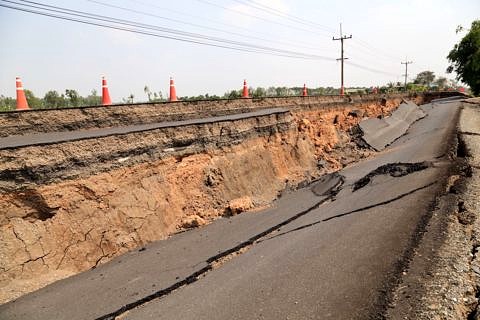Relics from earthquakes 70 kilometres deep

FAU scientist investigates rare fossil structures from an earthquake that occurred 45 million years ago
Information about current earthquakes is usually obtained using seismographic data. Scientists use this data to draw conclusions about the precise location of such natural events and the depth at which they occur. However, it is not possible to investigate which processes occur at the depth involved as earthquakes are inaccessible, especially if they occur along subduction zones at a depth of 50 to 300 kilometres. The risk of earthquakes is particularly high where the oceanic crust submerges underneath the continental plate.
In conjunction with researchers at the universities of Genoa and Padua, Dr. Michel Bestmann from the working group for Structural Geology and Tectonics at GeoZentrum Nordbayern at Friedrich-Alexander-Universität Erlangen-Nürnberg (FAU) has been investigating some very special fossil earthquake structures. These pseudotachylytes reached the Earth’s surface because of tectonic erosion processes. They were created when rock melted due to the high frictional heat during an earthquake that occurred 45 million years ago and solidified into glass.
‘Such evidence of fossil earthquakes is extremely rare’, says Michel Bestmann. ‘Our samples contain the only example worldwide of fossil earthquake structures that were formed in a subducted oceanic plate at a depth of 70 kilometres. Due to the extraordinary dryness of the rock and the minerals it contains, these structures survived the long journey to the Earth’s surface unscathed and with their structure intact’. These frictional melts were found in Moncuni, west of Turin in Italy.
‘These fossil earthquake structures were identified as such around ten years ago, but associated with earthquakes before the subduction process’, explains Bestmann. They have now been re-investigated. ‘This is because fossil earthquake structures represent processes that also occur today within circumpacific subduction zones.’
Bestmann provided the scanning electron microscope analyses and images. The first step involved producing transparent thin sections of the rock samples measuring 25-30 µm in thickness. Using a conventional optical microscope and high-resolution scanning electron microscopes, and in collaboration with materials scientists at FAU (Prof. Dr. Matthias Göken’s working group), structural geologist Bestmann analysed various parameters such as the proportion of certain minerals and their chemical composition and determined the pressure temperature at which the minerals formed. ‘We can calculate the depth at which these earthquakes occurred and which deformation processes led to the fossil earthquakes.’
This research will improve the understanding of deformation processes on the Earth’s crust as well as allow researchers to gain new insights into the behaviour of rocks during earthquakes in terms of certain tectonic plate events. Co-author Michel Bestmann and scientists from the universities of Padua and Genoa have published the results in Nature Geoscience: ‘Fossil intermediate-depth earthquakes in subducting slabs linked to differential stress release’. (doi: 10.1038/s41561-017-0010-7)
Further information:
Dr. Michel Bestmann
Phone: +49 9131 8529026
michel.bestmann@fau.de